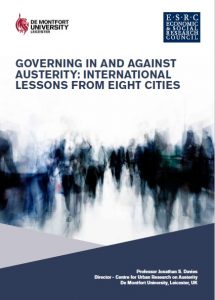 Professor Jonathan Davies introduces a new paper “Austerity Urbanism: Patterns of Neoliberalisation and Resistance in Six Cities of Spain and the UK”. The paper is co-authored with Ismael Blanco and published in Environment and Planning A. The article is fully open access and can be downloaded at the link above.
Professor Jonathan Davies introduces a new paper “Austerity Urbanism: Patterns of Neoliberalisation and Resistance in Six Cities of Spain and the UK”. The paper is co-authored with Ismael Blanco and published in Environment and Planning A. The article is fully open access and can be downloaded at the link above.
The relationship between austerity, neoliberalism and the governance of cities has been the source of intense debate since the 2008 crash. We develop a fresh perspective, through a six-case comparative analysis of austerity urbanism in Spain (Barcelona, Donostia, Lleida and Madrid) and the UK (Cardiff and Leicester).
We begin by looking at a continuum of perspectives on neoliberalism, from thinkers like Perry Anderson who see it as a globalising hegemonic strategy of historically unprecedented influence, to urbanists, who see it as infinitely variegated and even disappearing when studied under a fine-grain analytical lens. Our argument is that if, in the spirit of critical realism, we treat social life as stratified and scaled, then these analytical polarities are not mutually exclusive. Divergence at one level of analysis can underpin convergence at another – and indeed vice-versa. Convergence and divergence should therefore be understood in relational terms.
Following this intuition, our central argument is – perhaps unsurprisingly – that culturally, politically and economically diverse austerity regimes tend to strengthen neoliberalism in both Spain and the UK. Urban austerity regimes are far more strongly embedded in UK cities than in Spain, bearing witness to the enduring shadow cast over local politics by the Thatcherite shock of the 1980s. Yet, in cities where anti-austerity struggles are highly developed, as in Barcelona and Madrid, the potential for urban transformations is both tantalizing and fraught with difficulties. At the same time, the breadth of regional variation in Spain leads us to follow Patrick Le Gales (2016) in asking where “neoliberalism” begins and ends. Donostia, for example, retains a strong commitment to public welfare, made possible by the relative economic strength and autonomy of the Basque region and the durability of local welfarist traditions across the electoral divide. Hence, while explaining how local varieties of neoliberalism strengthen neoliberalism as a global project, we also recognize limits to the concept and the potential for overcoming it through resistance grounded in urban politics.
Theoretically, we follow a regime approach, developing a heuristic analysis based on Clarence N. Stone’s “iron law”. Stone (2015) states that for any governing regime to succeed, resources must be commensurate with the agenda pursued. This simple formulation provides a helpful lens for bringing our diverse case studies into a meaningful conversation with one another, around the question of what alliances are forged among which actors, mobilizing what resources in pursuit of which goals – and with what limitations? Applying this lens allows us to develop an inductive comparison around a thematically structured discussion of austerity governance and resistance in our six cities. Through this approach we benchmark the powers and limitations of neoliberal austerity regimes.
We finally consider the implications of our study for conceptualizing neoliberalism and for further developing urban regime analysis in the spirit of Stone’s iron law. The paper concludes with eight propositions to inform future studies of austerity urbanism. We hope readers find them useful and stimulating.
Jonathan Davies is Director of CURA and Professor of Critical Policy Studies at De Montfort University


